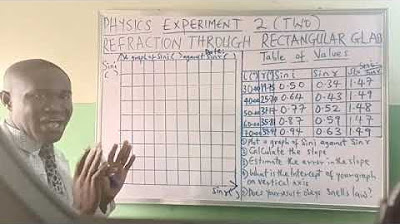Refraction of Light
Summary
TLDRThis video explores the concept of refraction, the bending of light as it passes from one medium to another, such as from air to water or glass. The presenter demonstrates this with simple experiments, including a magic trick using a glass of water to bend light. The video explains how light travels in a straight line until it encounters a different material, where its speed changes and causes refraction. Key terms like 'incident ray,' 'angle of incidence,' and 'angle of refraction' are introduced, followed by interactive questions to reinforce the learning.
Takeaways
- 💡 Light travels in a straight line, which is called rectilinear propagation.
- 🪄 A 'magic trick' can demonstrate the bending of light using a glass of water, showcasing the concept of refraction.
- 🌈 Refraction of light is the bending of light when it passes from one medium to another, such as from air to water or glass.
- 🚦 Light slows down when it enters a denser material (like glass), which causes the light to bend.
- 🔍 The angle of incidence and the angle of refraction explain how light behaves when passing between different materials.
- 📏 When light travels from a rarer to a denser medium, it bends towards the normal line, and when it goes from a denser to a rarer medium, it bends away from the normal.
- 🖊 Everyday examples of refraction include a pencil appearing bent in water and swimming pools looking shallower than they are.
- 🚫 When light hits a material at a 90-degree angle (normal incidence), there is no bending, though the speed still changes.
- ⚡ Optical density is different from normal density; it refers to how much a material slows down light.
- 📚 The video concludes with a set of practice questions on refraction and an invitation for viewers to engage and ask questions in the comments.
Q & A
What is rectilinear propagation of light?
-Rectilinear propagation of light refers to the concept that light travels in a straight line when it moves through a single medium.
What is refraction of light?
-Refraction of light is the change in the direction of light as it passes obliquely from one medium to another. This bending occurs due to a change in the speed of light when it enters a different material.
Why does light bend when it passes through different materials?
-Light bends when passing through different materials because the speed of light changes when it moves from one medium to another. For example, light slows down when it enters a denser medium like glass from a less dense medium like air, causing it to bend.
What is the difference between reflection and refraction of light?
-Reflection occurs when light bounces back from a surface, while refraction is the bending of light as it passes through different media. Reflection changes the direction of light but does not involve a change in speed.
What materials can cause refraction of light?
-Transparent materials such as glass, water, and plastic can cause refraction of light because they allow light to pass through while altering its speed.
What is the relationship between the angle of incidence and the angle of refraction?
-The angle of incidence is the angle between the incident light ray and the normal, while the angle of refraction is the angle between the refracted ray and the normal. When light moves from a rarer medium to a denser medium, the angle of incidence is greater than the angle of refraction.
What happens when light passes normally (perpendicularly) from one medium to another?
-When light passes perpendicularly from one medium to another, no bending occurs, but the speed of light still changes. In this case, the angle of incidence and the angle of refraction are both zero.
Why does a pencil appear bent when placed in a glass of water?
-A pencil appears bent when placed in a glass of water due to the refraction of light. The light rays bend as they pass from water to air, creating the optical illusion that the pencil is bent.
Why does a swimming pool appear shallower than it actually is?
-A swimming pool appears shallower than it is because of the refraction of light. As light passes from water to air, it bends, causing objects under the water to appear closer to the surface.
What causes light to bend more when passing through different media?
-The greater the change in the speed of light between two media, the more the light will bend. For instance, light slows down more significantly when it moves from air to glass, causing a larger bend.
Outlines

Cette section est réservée aux utilisateurs payants. Améliorez votre compte pour accéder à cette section.
Améliorer maintenantMindmap

Cette section est réservée aux utilisateurs payants. Améliorez votre compte pour accéder à cette section.
Améliorer maintenantKeywords

Cette section est réservée aux utilisateurs payants. Améliorez votre compte pour accéder à cette section.
Améliorer maintenantHighlights

Cette section est réservée aux utilisateurs payants. Améliorez votre compte pour accéder à cette section.
Améliorer maintenantTranscripts

Cette section est réservée aux utilisateurs payants. Améliorez votre compte pour accéder à cette section.
Améliorer maintenantVoir Plus de Vidéos Connexes

Refraction of Light - Introduction | Infinity Learn

Refraction and Snell's law | Geometric optics | Physics | Khan Academy

Physics for Engineers | Lesson 15.2 | Propagation of Light I

How to get your readings without touching any apparatus

Refraction of Light

Syifa Putri Hidayat_23060190072_ 5B_UAS Gelombang Optik
5.0 / 5 (0 votes)
